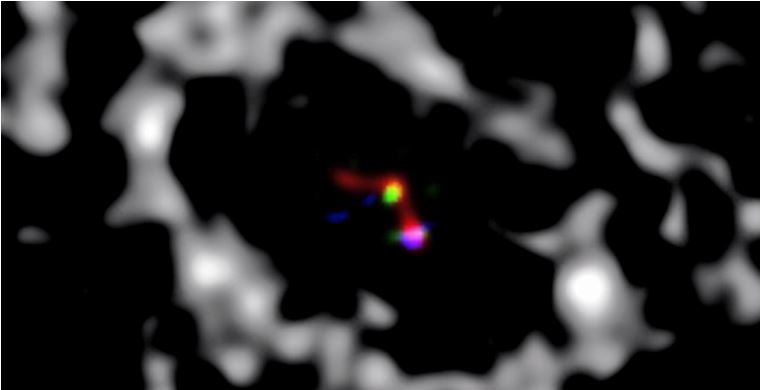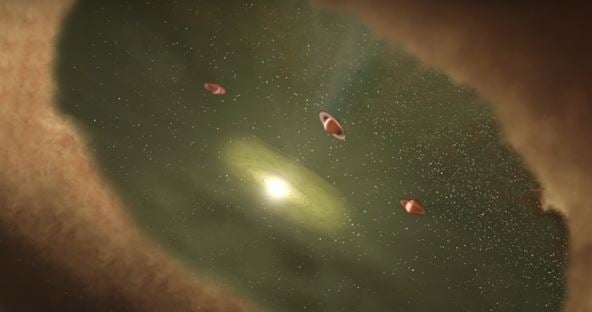Spectacular images of a new planet formation, when dust and gas particles accumulate and make a new planet, have been captured for the first time ever by a team of US and Australian scientists.
The astronomers and astrophysicists, from the University of Sydney and the University of Arizona, wrote about their incredible achievement in the academic journal Nature.
None of the nearly 1,900 exoplanets discovered so far are in the process of being formed. Their images, the authors say, are the first direct observation of an exoplanet being formed and continuing to grow. An exoplanet is a planet outside our Solar System that orbits a star.
 A composite image of LkCa15 shows the MagAO data, in blue, and the Large Binocular Telescope data, in green and red. (Image: University of Arizona)
A composite image of LkCa15 shows the MagAO data, in blue, and the Large Binocular Telescope data, in green and red. (Image: University of Arizona)
Distant star gives birth
A star 450 light years away, called LkCa 15, has been observed exhibiting all the symptoms of a mother about to give birth. It is surrounded by an enormous disc of gas and dust, making it just the right environment where planets can grow. Within the dust they detected distinct signs of disturbance – something within the disc had eaten away part of it.
Co-author, Professor Peter Tuthill, ARC Future Fellow in the School of Physics and director of the Sydney Institute for Astronomy (SIfA) at the University of Sydney, Australia, said the images provided compelling evidence.
Prof. Tuthill, said:
“This is the first time we’ve imaged a planet that is definitely still in the process of forming. The photo provided the proof: The difficulty had been that when you have indirect evidence, there are always alternate explanations that might fit the data.”
Thanks to specialized instruments, scientists today are able to image objects that were near and much fainter than a nearby star. These include the University of Arizona’s Magellan Telescope and its Adaptive Optics System, MagAO, located in Chile, and the largest telescope in the world – the Large Binocular Telescope – located on Mount Graham, Arizona.
 Artist’s illustration of planetary formation. (Image: University of Arizona)
Artist’s illustration of planetary formation. (Image: University of Arizona)
Distant object difficult to photograph
The main difficulty when trying to capture images of distant objects is atmospheric turbulence, the authors explained.
Professor Laird Close, who works at the Department of Astronomy and Steward Observatory at the University of Arizona, said:
“When you look through the Earth’s atmosphere, what you’re seeing is cold and hot air mixing in a turbulent way that makes stars shimmer. To a big telescope, it’s a fairly dramatic thing; you see a horrible looking image. The breakthrough was possible because the Large Binocular Telescope was purpose-built, incorporating a novel imaging technique to sharpen the images.”
Meanwhile Dr. Kate Follette and Prof. Close used the MagAO (Magellan’s adaptive otpics system) independently to confirm the discovery. Using its unique ability to work in visible wavelengths, they captured the exoplanet’s ‘hydrogen alpha’ spectral fingerprint – the specific light wavelength emitted by LkCa 15 and its planets as they grow.
When cosmic bodies are forming, they become extremely hot, and because they are being formed from hydrogen, they all glow a deep red, which scientists refer to as H-alpha, a particular wavelength of light.
Dr. Follette explained that that single shade of red light was emitted by both the star and the planet, as they underwent the same growing process.
Dr. Follette added:
“We were able to separate the light of the faint planet from the light of the much brighter star and to see that they were both growing and glowing in this very distinct shade of red.”
It was thanks to the application of a lot of super-advanced technology to the business of imaging the stars that these results were possible, the researchers said said.
Prof. Tuthill said:
“It’s fantastic to see these cutting-edge instruments now enabling us to make such exciting discoveries.”
Citation: “Accreting protoplanets in the LkCa 15 transition disk,” S. Sallum, K. B. Follette, J. A. Eisner, L. M. Close, P. Hinz, K. Kratter, J. Males, A. Skemer, B. Macintosh, P. Tuthill, V. Bailey, D. Defrère, K. Morzinski, T. Rodigas, E. Spalding, A. Vaz & A. J. Weinberger. Nature. 18 November, 2015. DOI: 10.1038/nature15761.
Video – New planet formation

